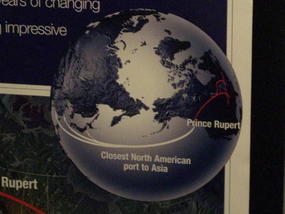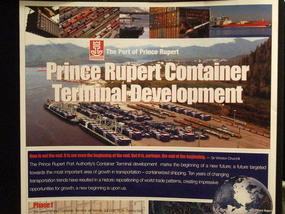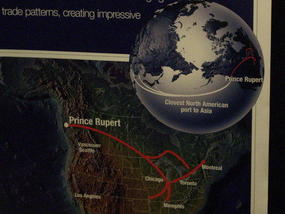_________________________________________________
YOU TUBE - http://www.youtube.com/user/TravelsWithLobo
---------------------------------------------------------------------------------
Date Visited: Oct. 14, 2006
Date Blog written: Jan. 13, 2007
From Prince George 722 km
Previous Stop: Terrace, BC
Prince Rupert - The New World Port
or
The Most Exciting Economic News in Northern BC in a Long Time!
It's For Real!
By far the most anticipated project in Northern British Columbia is the construction of the Fairview Container Port Terminal - Phase I in Prince Rupert. It will be an international ninety-eight percent inter-modal (ship to railway) container transportation hub of major importance to Northern British Columbia.
The key word is of course "container" since this is the wave of the present.
The exciting news is that this is one project that is not only well past the talking stage, but is in fact well underway. To put it more bluntly - it is scheduled for opening in October 2007-on schedule and on budget.
The Pacific Gateway Strategy
The "Pacific Gateway Strategy", spearheaded by the federal and provincial governments, involves a major expansion of Vancouver's port and transportation facilities as well as the creation of the container port in Prince Rupert and the expansion of a "North-West Transportation Corridor" which falls mainly into the hands of the Canadian National Railway.
At present, of the 23 million containers shipped through the west coast, only 2.1 million, or a little over 9% of container traffic, flows through Vancouver, presently Canada's only west coast container port.
With the expansion of Vancouver and the addition of Prince Rupert as a container port, it is projected that the container traffic will grow to 4 million units or to 17% of total container traffic on the west coast. The rest would flow through Seattle, Tacoma, Portland, San Francisco, Oakland and Los Angeles (Long Beach).
The Rationale
This is the "Age Pacifica" which is characterized by unprecedented growth of the Asian economy and the fact that China now is Canada's second largest trading partner after the United States.
This growth is the impetus for a world class container port which would take advantage of Prince Rupert's strategic position between the markets of Asia - China, South Korea, Japan, and India --and the American mid-west city of Chicago.
From this major distribution point goods would have easy access to the major markets of the East,
The Partners
This $110 million investment is the result of a partnership between the Prince Rupert Port Authority, Maher Terminals of Canada Corp.(MTCC) who will be port's operators, CN Rail, the BC Provincial Government, and the Federal Government.
The Details
Phase One is in fact the expansion of the existing Fairview wharf, followed by the upgrading of the remaining wharf and inter-modal yard. It will include three 1,800 tonne gantry cranes with 64-tonne lift capacity. Known as Super Post Panama cranes, they will be provided by Maher Terminals of Canada.
The new Fairview Container Terminal (Phase I) will move 500,000 (Twenty Foot Equivalent Units) (containers) per year and will create some 250 to 300 jobs.
It will be designed to handle the largest concentration of inter-modal business and will constitute North America's purest marine to rail inter-modal transfer facility.
The 18 meter extension of the wharf will allow for a berth depth of 16.75 meters which will permit the accommodation of the largest container ships now on the drawing board. Those ships will hold up to 12,500 TEUs, making them 22 containers across.
Canadian National Railway (CN) will play an important part in this expansion insofar as the inter-modal yard will be expanded to seven working tracks and six storage tracks, enough to hold 17,000 feet of train.
The Prince Rupert Advantages
As alluded to above, it is after all -- location, location, location.
As a result, Prince Rupert has several natural advantages over other ports such as Vancouver, Seattle, Tacoma, Portland, San Francisco, Oakland, Los Angeles, Long Beach.
Prince Rupert, and by extension Prince George, is on the shortest sea-land route from Asia to the most economically significant part of the United States-the mid-west and east.
To me the "shortest sea-land route" aspect was perhaps the most surprising fact that came out of this story. However, since Columbus (and perhaps before) we have known that the earth is not flat and this revelation should not have been a surprise.
My initial belief was that Prince Rupert was at the end of nowhere and thereby not subject to being part of this revolution in transportation that was brought about by economic growth spurred by the so-called "Asian economic tigers".
The fact that Prince Rupert has a two day sailing advantage over a major port like Los Angeles is a compelling argument which cannot be ignored.
The point is made with the following distances from Hong Kong:
Prince Rupert 5,286 km
Vancouver 5,777 km
Seattle 5,768 km
Los Angeles 6,380 km.
Another natural advantage is that Prince Rupert has, by far, the deepest Inner Harbour access channel (35-44 meters) and is therefore suitable for the biggest post-Panamax container vessels now on the drawing boards.
Another part of location is room for expansion without incursion on urban areas.
Upon the completion of Phase I, work is to start immediately upon Phase II which is projected to be operational in 2009 and calls for an additional investment of $500 million, providing an annual capacity of 2,000,000 containers, and creating an additional 750 jobs.
Eighty percent of the engineering studies for Phase II have been completed to date.
Another factor, which is a spin off of location, would be lack of congestion.
Around Prince Rupert and the North-West Transportation Corridor there is very little congestion as compared to the other ports which are in major urban areas full of all kinds of congestion. The new corridor would be going through the lightest populated areas in North America.
Advantages of a "non-natural nature" would include the fact that Prince Rupert also offers a long history of peaceful labour negotiations with the International Longshore and Warehouse Union (ILWU) Local 505.
The container port would also offer 100% container screening by the Canadian Border Services Agency (CBSA) which no other port on the west coast is offering at this time. This would also create an additional 48 positions to be filled.
Economic Spin-Offs
As part of the Gateway Express, it is expected that economic spin-offs will accrue to other communities along the CN railway corridor.
The driving force of this initiative would of course not only be the incoming container traffic but also the search for widgets to put into empty returning containers.
This could include:
-Alaskan and local sea food
- pork
- beef
- forest products, in which the Prince George area is number one in North America
- agricultural products
- petrochemicals and plastics
- cotton and re-cycled paper from the south-east
- log and modular home components
The economic spin-off would be far-reaching and pervasive.
Waves of anticipation reverberate to Prince George, Edmonton, Grand Prairie and Saskatoon all expecting to participate with Inland Port developments.
It is hoped that this would be an economic injection for the whole region which would create a feeling of optimism essential for the building of momentum for the local economies.
Here in Prince George it is a topic of much speculation and conjecture as to how and when the local economy can actualize this concept of an Inland Port Facility which would accommodate the movement of goods to the container port in Prince Rupert.
Prince George, being the most important Northern BC transportation hub, is located at a strategic intersection of Highways 16 and 97 as well as the north-south, east-west CN (BC Rail) lines.
Any containers on the way to Prince Rupert must pass through Prince George.
In addition, financing for the Prince George International Airport $33 million runway expansion to 11,400 feet seems within reach. To date, the BC Northern Trust and the Federal Government have already committed to their financial support.. It is expected that an announcement from the BC Provincial Government on this matter will be coming soon.
As a potential stop for large cargo planes and the creation of a cargo-handling facility, the airport would be a possible addition to the flow of cargo into and out of the corridor.
Given these factors, it is hard to see that Prince George, of all places, would not have a share of this economic pie.
A key challenge therefore, beyond the actual port, is the building of the infrastructure to support the new container traffic
The North-West Transportation Corridor
As an important part of this "Gateway Express", CN (Canadian National Railway) will invest in the neighbourhood of $390 million in the Prince Rupert Container Port and upgrading of the northern BC railway line, including:
- the container port inter-modal yard and track work -- $25 million
- track work for double stacked containers clearance and siding extensions -- $55 million
- 50 new state-of-the-art locomotives and new rail cars -- $290 million
- transload facilities -- $20 million
With CN's network of tracks reaching to New Orleans, there is significant potential for throughput capacity on the part of the railway to maintain their leading position in North America as a transporter of goods and a major player in the "Gateway Express".
As an example, the CN line across the Rockies requires only two locomotives to haul a container train due to its gentle incline.
The CN Rail Prince Rupert line is currently operating at 10% capacity allowing for lots of expansion.
With the completion of Phase 1 of the Container Port, it is expected that four trains a day, two going west for the back haul and two going east with stuffed double-stacked containers, will be added to the mix.
It is easy to see why economic expectations have been considerably heightened for Northern British Columbia and beyond by the events which are unfolding in Prince Rupert.
It does also illustrate the obvious point that for economic development to take place, there has to be a lot of will on the part of governments and private enterprise to commit large sums of money and to undertake large risks in the hope of future economic payoff which may or may not come to fruition.
The future looks bright but it will no doubt not be devoid of growing pains and setbacks which only time will sort out.
Update:
Feb. 23, 2007
In what could be considered good news, the operator of the terminal port, Maher Terminal, has been purchased by RREEF Infrastructures.
This is quite a mouthful but, RREEF Infrastructures is a part of Alternative Investments, the global alternatives asset management business of Deutsche Bank's Asset Management division.
Considering the global reach of Deutsche Bank and the fact that the purchase includes Maher Terminals extensive holdings in Port Elizabeth, New Jersey, this could definitely be interpreted as a vote of confidence for the yet unopened container port in Prince Rupert.
Coming:
a look at the container facilities in Long Beach, California
Sources:
-Prince Rupert Economic Development Corporation
-Prince Rupert Port Authority
-Presentation by Shaun Stevenson
Vice President Marketing and Business Development, Port of Prince Rupert
on Jan. 12, 2007
2007 BC Natural Resource Forum and Trade Show, Prince George
_________________________________________________
YOU TUBE - http://www.youtube.com/user/TravelsWithLobo
---------------------------------------------------------------------------------
Prince Rupert -- The New World Port
Sunday, January 14, 2007
 Prince Rupert, British Columbia, Canada
Prince Rupert, British Columbia, Canada
Other Entries
-
1Bear Alley - Highway 37 to Stewart/Hyder Alaska
Oct 04102 days prior Stewart BC, Canadaphoto_camera35videocam 0comment 2
Stewart BC, Canadaphoto_camera35videocam 0comment 2 -
2Stewart BC -- Historic Gateway to Alaska
Oct 05101 days prior Stewart BC, Canadaphoto_camera34videocam 0comment 2
Stewart BC, Canadaphoto_camera34videocam 0comment 2 -
3Stewart BC -- Ripley Creek Inn and the Estuary
Oct 05101 days prior Stewart BC, Canadaphoto_camera41videocam 0comment 0
Stewart BC, Canadaphoto_camera41videocam 0comment 0 -
4Hyder, Alaska -- Fish Creek and Salmon Glacier
Oct 1294 days prior Hyder, United Statesphoto_camera59videocam 0comment 3
Hyder, United Statesphoto_camera59videocam 0comment 3 -
5One of Nature's Great Stories
Oct 1888 days prior Adams River, Canadaphoto_camera63videocam 0comment 0
Adams River, Canadaphoto_camera63videocam 0comment 0 -
6Prince Rupert -- The New World Port
Jan 14 Prince Rupert, Canadaphoto_camera3videocam 0comment 0
Prince Rupert, Canadaphoto_camera3videocam 0comment 0 -
7Prince Rupert: Sinking of the Queen of the North
Apr 0379 days later Prince Rupert, Canadaphoto_camera3videocam 0comment 0
Prince Rupert, Canadaphoto_camera3videocam 0comment 0 -
8On The Road Again - Northwest Territories
Jun 20157 days later Prince George, Canadaphoto_camera1videocam 0comment 0
Prince George, Canadaphoto_camera1videocam 0comment 0 -
9Prince George to Dawson Creek - DAY 1
Jun 21158 days later Dawson Creek, Canadaphoto_camera38videocam 0comment 0
Dawson Creek, Canadaphoto_camera38videocam 0comment 0 -
10Dawson Creek to Fort Nelson - Day 2
Jun 23160 days later Fort Nelson, Canadaphoto_camera55videocam 0comment 0
Fort Nelson, Canadaphoto_camera55videocam 0comment 0 -
11The Liard Highway - Day 3
Jun 23160 days later Fort Liard, Canadaphoto_camera73videocam 0comment 2
Fort Liard, Canadaphoto_camera73videocam 0comment 2 -
12Fort Simpson to Yellowknife - Day 4
Jun 24161 days later Yellowknife, Canadaphoto_camera61videocam 0comment 0
Yellowknife, Canadaphoto_camera61videocam 0comment 0 -
13Yellowknife - The Old Town - Day 5
Jun 26163 days later Yellowknife, Canadaphoto_camera41videocam 0comment 1
Yellowknife, Canadaphoto_camera41videocam 0comment 1 -
14Yellowknife - The New Town - Day 5
Jun 26163 days later Yellowknife, Canadaphoto_camera41videocam 0comment 0
Yellowknife, Canadaphoto_camera41videocam 0comment 0 -
15Yellowknife - Frame Lake - Day 5
Jun 26163 days later Yellowknife, Canadaphoto_camera53videocam 0comment 0
Yellowknife, Canadaphoto_camera53videocam 0comment 0 -
16Yellowknife - The Legislative Assembly
Aug 04202 days later Yellowknife, Canadaphoto_camera30videocam 0comment 1
Yellowknife, Canadaphoto_camera30videocam 0comment 1 -
17Yellowknife - Prince of Wales Northern Heritage Ct
Aug 06204 days later Yellowknife, Canadaphoto_camera22videocam 0comment 0
Yellowknife, Canadaphoto_camera22videocam 0comment 0 -
18On The Road Again - Discovery Coast
Aug 12210 days later Prince George, Canadaphoto_camera0videocam 0comment 0
Prince George, Canadaphoto_camera0videocam 0comment 0 -
19Discovery Coast Passage - Part 1 of 12
Aug 20218 days later Alexis Creek, Canadaphoto_camera55videocam 0comment 0
Alexis Creek, Canadaphoto_camera55videocam 0comment 0 -
20Discovery Passage - Part 2 of 12
Aug 20218 days later Tatla Lake, Canadaphoto_camera57videocam 0comment 2
Tatla Lake, Canadaphoto_camera57videocam 0comment 2 -
21Heckman Pass to Bella Coola - Part 3
Aug 20218 days later Tweedsmuir Provincial Park, Canadaphoto_camera62videocam 0comment 2
Tweedsmuir Provincial Park, Canadaphoto_camera62videocam 0comment 2 -
22Bella Coola - the Port - Part 4
Aug 25223 days later Bella Coola, Canadaphoto_camera26videocam 0comment 0
Bella Coola, Canadaphoto_camera26videocam 0comment 0 -
23The Discovery Coast Passage - Part 5
Aug 27225 days later Bella Coola, Canadaphoto_camera80videocam 0comment 3
Bella Coola, Canadaphoto_camera80videocam 0comment 3 -
24Port Hardy to Campbell River to Parksville
Aug 30228 days later Campbell River, Canadaphoto_camera2videocam 0comment 0
Campbell River, Canadaphoto_camera2videocam 0comment 0

 Prince Rupert, British Columbia, Canada
Prince Rupert, British Columbia, Canada




2025-05-22